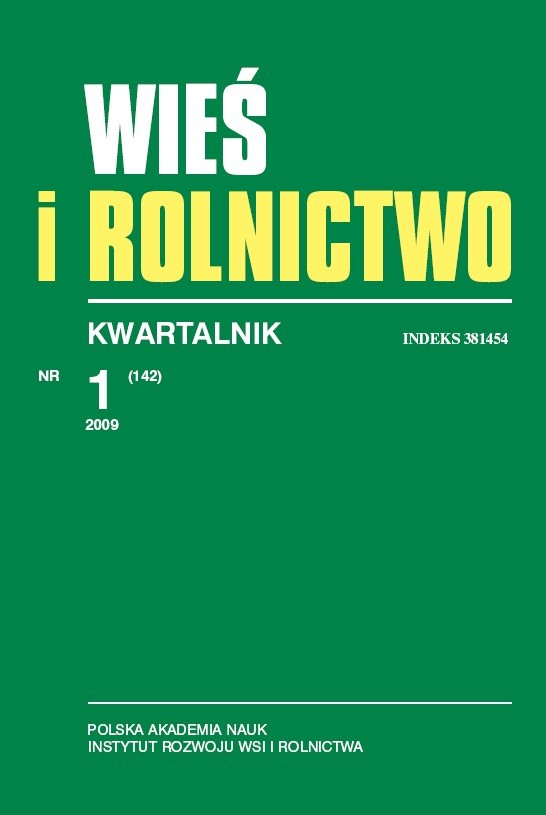Determinanty sukcesu współpracy na rynkach rolniczych na przykładzie grup producentów w Polsce
DOI:
https://doi.org/10.53098/wir.2009.1.142/06Słowa kluczowe:
współpraca, rynki rolne, grupy producentów rolnychAbstrakt
Główne pytanie badawcze w artykule dotyczy kwestii, dlaczego niektóre organizacje nastawione na współpracę na rynkach rolnych odnoszą sukces, a inne z kolei zaprzestają działalności. Analiza empiryczna opiera się na danych pochodzących z 62 grup producentów rolnych z Wielkopolski. Głównym zadaniem grup producentów jest wspólna organizacja sprzedaży dóbr produkowanych indywidualnie przez ich członków. Niektóre z tych organizacji funkcjonowały bardzo efektywnie, podczas gdy inne zostały rozwiązane lub zaprzestały wykonywania podstawowych funkcji. Zmienne, takie jak: siła przywództwa, wcześniejsze kontakty biznesowe, początkowa selekcja członków, jak również liczba członków okazały się mieć pozytywny i ważny statystycznie wpływ na prawdopodobieństwo odniesienia sukcesu przez badane organizacje.Bibliografia
Ahn T.K., Ostrom E., Schmidt D., Shupp R., Walker J., 2001: Cooperation in PD Games: Fear, Greed, and History of Play. „Public Choice” 106(1–2): 137–155. DOI: https://doi.org/10.1023/A:1005219123532
Axelrod R., 1984: The Evolution of Cooperation. Basic Books, New York.
Banaszak I., 2006: Producer Groups in Poland. Empirical Survey Results. „Annals of the Polish Association of Agricultural and Agribusiness Economists” 7(6): 5–10.
Banaszak I., 2008: Agricultural Producer Groups in Poland: Empirical Survey Results. „Journal of Rural Cooperation” 36 (1).
Banaszak I., Beckmann V., 2006: Compliance with Rules and Sanctioning in Producer Groups in Poland. IDARI Working Paper, Humboldt University, Berlin.
Banaszak I., Beckmann V., 2007: The Role of Leadership in Establishing and Sustaining Cooperation. Evidence from Producer Groups in Poland. In: Managing Economic, Social and Biological Transformations. Eds. A. Knierim, U.J. Nagel, C. Schäfer. Proceedings of the First Green Week Scientific Conference, Margraf Publishers, Weikersheim.
Bianco W.T., Bates R.H., 1990: Cooperation by Design: Leadership, Structure, and Collective Dilemmas. „The American Political Science Review” 84(1): 133–147. DOI: https://doi.org/10.2307/1963633
Binger B.R., Hoffman E., 1989: Institutional Persistence and Change: The Question of Efficiency. „Journal of Institutional and Theoretical Economics” 145: 67.
Bonus H., 1986: The Cooperative Association as a Business Enterprise: A Study in the Economics of Transactions. „Journal of Institutional and Theoretical Economics” 142: 310.
Borgen S.E., 2004: Rethinking Incentive Problems in Cooperative Organizations. „Journal of Socio-Economics” 33: 383–393. DOI: https://doi.org/10.1016/j.socec.2004.04.010
Bowersox D.J., Closs D.J., Stank T.P., 1999: 21st Century Logistics: Making Supply Chain Integration a Reality. Council of Logistics Management, Oak Brook.
Brosig J., Weimann J., 2003: The Effect of Communication Media on Cooperation. „German Economic Review” 4(2): 217–241. DOI: https://doi.org/10.1111/1468-0475.00080
Bruynis C., Hahn D.E., Taylor W.J., 1997: Critical Success Factors for Emerging Agricultural Marketing Cooperatives. An annual publication of the National Council of Farmer Cooperatives. American Cooperation, Washington, DC.
Caputo M., Mininno V., 1996: Internal, vertical and horizontal logistics integration in Italian grocery distribution. „International Journal of Physical Distribution & Logistics Management” 26(9): 64–90. DOI: https://doi.org/10.1108/09600039610149101
Ejsmont J., Milewski R., 2005: Podstawy prawne tworzenia i działalności grup producentów. Fundacja Wspomagania Wsi, Warszawa. (www.witrynawiejska.org.pl/images/15208_grprod.pdf).
Foss N.J., 1999: Understanding Leadership: A Coordination Theory. DRUID Working Paper 99–3.
Haag M., Lagunoff R., 2003: On the Size and Structure of Group Cooperation. Fondazione Eni Enrico Mattei Working Paper 54.2003, Georgetown University Working Paper 03-02.
Hansmann H,. 1996: The Ownership of the Enterprise. The Belknap Press of Harvard University Press, Cambridge, London.
Hendrikse G.W.J., 2007: Two Vignettes regarding Boards in Cooperatives versus Corporations: Irrelevance and Incentives. In: Vertical Markets and Cooperative Hierarchies. Eds. K. Karantininis, J. Nilsson. Springer, Dordrecht. DOI: https://doi.org/10.1007/1-4020-5543-0_8
Kleindorfer P.R., Kunreuther H.C., Schoemaker P.J.H., 1993: Decision Sciences. An Integrative Perspective. Cambridge University Press. Cambridge. DOI: https://doi.org/10.1017/CBO9781139173537
Kollock P., 1998: Social Dilemmas: The Anatomy of Cooperation. „Annual Review of Sociology” 24: 183–214. DOI: https://doi.org/10.1146/annurev.soc.24.1.183
Kräkel M., 2006: On the „Adverse Selection” of Organizations. IZA Discussion Paper, University of Bonn. DOI: https://doi.org/10.2139/ssrn.943468
Kreps D.M., 1996: Markets and Hierarchies and (Mathematical) Economic Theory. „Industrial and Corporate Change” 5(2): 561–595. DOI: https://doi.org/10.1093/icc/5.2.561
Lemanowicz M., 2005: Organizacje i grupy producentów szansą na poprawę konkurencyjności polskiego rolnictwa. Wydawnictwo SGGW, Warszawa.
Long J.S., Freese J., 2001: Regression Models for Categorical Dependent Variables Using Stata. Stata Press, College Station.
Ménard C., 2004: The Economics of Hybrid Organizations. „Journal of Institutional and Theoretical Economics” 160: 345–376. DOI: https://doi.org/10.1628/0932456041960605
Ménard C., 2005: A New Institutional Approach to Organization. In: Handbook of New Institutional Economics. Eds. C. Ménard, M. Shirley. Springer: 281–318. DOI: https://doi.org/10.1007/0-387-25092-1_13
Ménard C., 2006: Hybrid Organization of Production and Distribution. „Revista de Análisis Económico” 21(2): 25.
Milgrom P.R., 1988: Employment Contracts. Influence Activities, and Efficient Organization Design. „The Journal of Political Economy” 96(1): 42–60. DOI: https://doi.org/10.1086/261523
Miller G.J., 1992: Managerial Dilemmas. The Political Economy of Hierarchy. Cambridge University Press, New York. DOI: https://doi.org/10.1017/CBO9781139173742
Olson M., 1965: The Logic of Collective Action. Public Goods and the Theory of Groups. Harvard University Press, Cambridge, London. DOI: https://doi.org/10.4159/9780674041660
Pallant J., 2001: SPSS Survival Manual. A Step by Step guide to Data Analysis using SPSS for Windows (Version 10). Open University Press, Buckingham.
Schaefer S., 1998: Influence Costs. Structural Inertia, and Organizational Change. „Journal of Economics & Management Strategy” 7(2): 237–263. DOI: https://doi.org/10.1111/j.1430-9134.1998.00237.x
Sexton R.J., Iskow J., 1988: Factors Critical to the Success or Failure of Emerging Agricultural Cooperatives. Giannini Foundation Information Series, 88(3).
Shamir B., House R., Arthur M.B., 1993: The Motivational Effects of Charismatic Leadership: A Self-Concept Based Theory. „Organisational Science” 4(4): 577–594. DOI: https://doi.org/10.1287/orsc.4.4.577
Spulber D.F., 1999: Market Microstructure: Intermediaries and the Theory of the Firm. Cambridge University Press, Cambridge. DOI: https://doi.org/10.1017/CBO9780511625930
Whipple J.M., Frankel R., 2000: Strategic Alliance Success Factors. „The Journal of Supply Chain Management: A Global Review of Purchasing and Supply”, August: 21–28. DOI: https://doi.org/10.1111/j.1745-493X.2000.tb00248.x
Williamson O.E., 1983: Peer Groups and Simple Hierarchies. In: O.E. Williamson: Markets and Hierarchies: Analysis and Antitrust Implications. The Free Press, New York.
Ziegenhorn R., 1999: Networking the Farm. The Social Structure of Cooperation and Competition in Iowa Agriculture. Aldershot, Asgate,Vermont.
Pobrania
Liczba pobrań artykułu
Strony
Jak cytować
Numer
Dział
Licencja
Prawa autorskie (c) 2009 Wieś i Rolnictwo

Utwór dostępny jest na licencji Creative Commons Uznanie autorstwa 4.0 Międzynarodowe.










